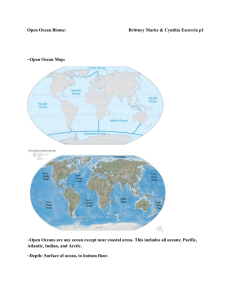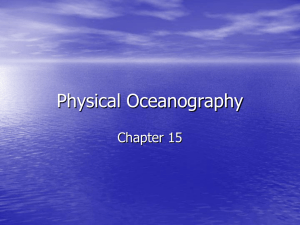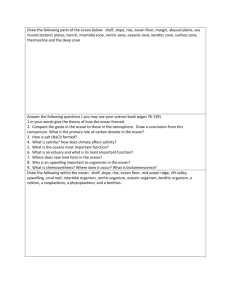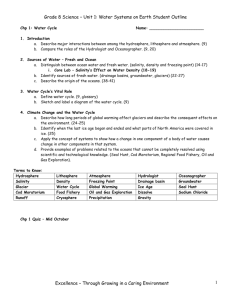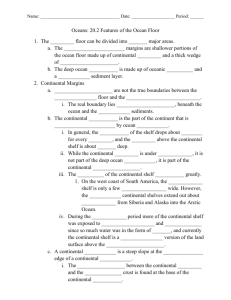Exploring the Oceans Web Quest
advertisement
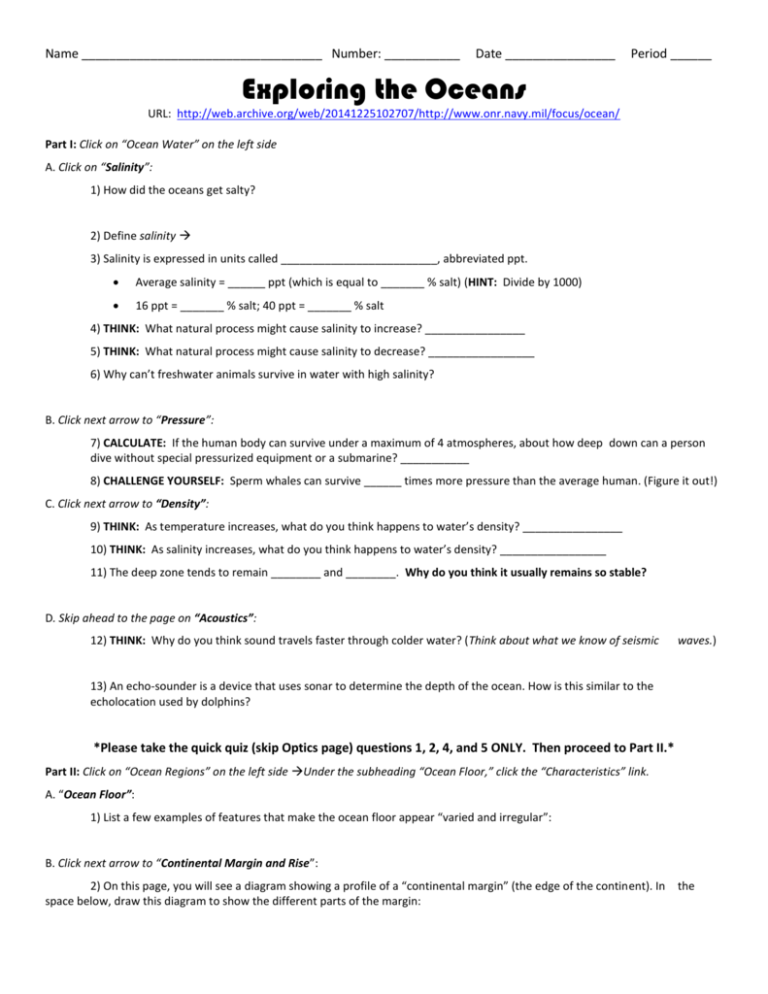
Name ___________________________________ Number: ___________ Date ________________ Period ______ Exploring the Oceans URL: http://web.archive.org/web/20141225102707/http://www.onr.navy.mil/focus/ocean/ Part I: Click on “Ocean Water” on the left side A. Click on “Salinity”: 1) How did the oceans get salty? 2) Define salinity 3) Salinity is expressed in units called _________________________, abbreviated ppt. Average salinity = ______ ppt (which is equal to _______ % salt) (HINT: Divide by 1000) 16 ppt = _______ % salt; 40 ppt = _______ % salt 4) THINK: What natural process might cause salinity to increase? ________________ 5) THINK: What natural process might cause salinity to decrease? _________________ 6) Why can’t freshwater animals survive in water with high salinity? B. Click next arrow to “Pressure”: 7) CALCULATE: If the human body can survive under a maximum of 4 atmospheres, about how deep down can a person dive without special pressurized equipment or a submarine? ___________ 8) CHALLENGE YOURSELF: Sperm whales can survive ______ times more pressure than the average human. (Figure it out!) C. Click next arrow to “Density”: 9) THINK: As temperature increases, what do you think happens to water’s density? ________________ 10) THINK: As salinity increases, what do you think happens to water’s density? _________________ 11) The deep zone tends to remain ________ and ________. Why do you think it usually remains so stable? D. Skip ahead to the page on “Acoustics”: 12) THINK: Why do you think sound travels faster through colder water? (Think about what we know of seismic waves.) 13) An echo-sounder is a device that uses sonar to determine the depth of the ocean. How is this similar to the echolocation used by dolphins? *Please take the quick quiz (skip Optics page) questions 1, 2, 4, and 5 ONLY. Then proceed to Part II.* Part II: Click on “Ocean Regions” on the left side Under the subheading “Ocean Floor,” click the “Characteristics” link. A. “Ocean Floor”: 1) List a few examples of features that make the ocean floor appear “varied and irregular”: B. Click next arrow to “Continental Margin and Rise”: 2) On this page, you will see a diagram showing a profile of a “continental margin” (the edge of the continent). In the space below, draw this diagram to show the different parts of the margin: 3) Define the following terms: Continental shelf Continental slope Continental rise Continental margin 4) Why is so much marine life found on the continental shelf? 5) THINK: The continental margin in this diagram is a passive margin (as opposed to an active margin). Why do you think this area would be considered “passive”? 6) THINK: What would you expect to find at an active margin? (Think about plate tectonics!)____________________ C. Click next arrow to “Deep Ocean Basin”: 7) The continental margins are the shallow parts of the ocean nearer to the shore. The rest of the ocean is (averaging between 2.5 and 3.5 miles in depth) is called the ______________________________. 8) The deepest parts of the ocean are the _________________ which can reach depths of ____________ miles. 9) Why is the abyssal plain so flat? D. Click next arrow to “Mid-Ocean Ridge”: 10) Describe what a rift valley is and where it can be found: 11) What’s the difference between a seamount and an island? *Please take the quick quiz questions 1- 4 ONLY. Then proceed to Part III.* Part III: Blue Water Click on the Ocean Regions logo on the left again, and then click “Characteristics” under the “Blue Water” subheading. A. “Characteristics”: 1) Most of the ocean environment consists of very deep water beyond the shallow coastal region. This open ocean environment is sometimes referred to, simply, as _____________________. 2) List and define the two basic environments that are home to all ocean life: 3) The pelagic environment is further divided into two more biological zones. List and define them here: 4) What is the difference between zooplankton and phytoplankton? 5) What type of community thrives in the deepest parts of the aphotic zone where no sunlight can reach? Click the link for more information, and explain how these communities can survive with no light.
